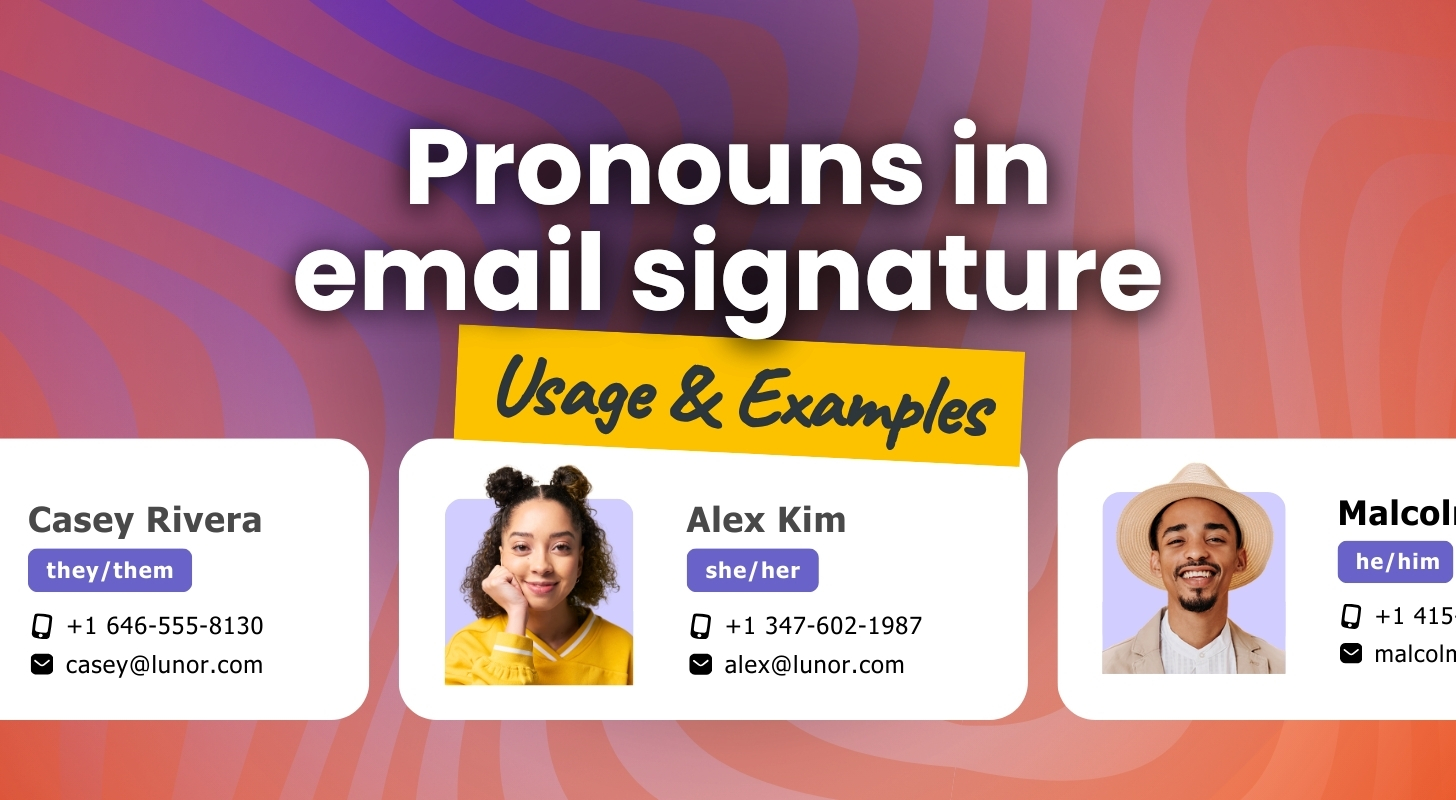In today’s evolving professional landscape, the practice of including personal pronouns in email signature sections (like she/her, he/him, or they/them) has become increasingly common. Seen across emails, messaging platforms, and social media profiles, this addition is more than just a matter of grammar. It reflects a growing awareness and acknowledgment of gender identity and diversity in the workplace. Sharing pronouns helps to communicate a key part of personal identity and encourages respectful interactions from the outset. This article explores the nuances of using pronouns in professional email signatures.
What Is a Pronoun in an Email Signature?
Pronouns are words used to refer to someone in the third person without using their name (e.g., ‘She is presenting today’, ‘Ask him for the report’, ‘They sent the email’). In an email signature, listing pronouns like (she/he/they) proactively informs others how you wish to be referred to. This simple act helps ensure respectful and accurate communication.
Examples of Pronouns in Email Signature
Common pronouns:
- she/her/hers
- he/him/his
- they/them/theirs
Some people use neopronouns like ze/zir/zem or combinations such as she/they or he/they.

Examples of pronouns might look like:
Jack Taveon (they/them/theirs)
Product Designer | Nexora Studios
M: +1 646 555 0274
E: [email protected]Lola Vantoré (she/her)
Senior Brand Strategist
📞 +1 312-555-0186
📧 [email protected]Manolo Avenza
Pronouns: He/Him/His
Technical Project Manager
P: +1 415 555 0341
E: [email protected]
Solentra Dynamics
www.solentra.techFor more specific examples, read our next article: Examples of pronouns in email signature: Visual & placement tips
Why Add Pronouns to an Email Signature
Adding pronouns to your email signature offers several benefits for workplace communication and culture:
- Improves clarity and prevents misgendering:
It removes guesswork, especially when names are gender-neutral, ambiguous, or unfamiliar across cultures. Preventing misgendering avoids causing hurt, distress, or alienation, particularly for transgender and non-binary individuals. - Fosters inclusion and respect:
It signals that you and your organization value diversity and are committed to creating a welcoming environment for people of all gender identities. Using correct pronouns is a fundamental aspect of showing respect, similar to using someone’s correct name. This contributes to psychological safety and a sense of belonging. - Normalizes gender diversity and shows empathy:
When pronoun sharing becomes common, it helps normalize gender diversity in the workplace. This eases the burden on transgender and non-binary individuals who might feel singled out. This act signals connection and helps cultivate safer, more welcoming spaces for everyone.
How to Add Pronouns to Email Signature
There are three main ways to add pronouns to your email signature, depending on how it’s created.
- The first option is to add pronouns directly in Gmail’s or Outlook’s built-in signature editor.
- The second is for custom-coded HTML signatures – you’ll need to insert the pronouns into the source code and reapply it in your email client.
- The third applies if your signature is managed through a central signature management app (commonly used in companies); in that case, you can either update it within the platform or ask your IT or HR team to do it for you, depending on your access rights to the app.
For exact steps, head over to our full tutorial on adding gender pronouns to email signatures.
Why Not to Include Pronouns in Email Signature
Despite the benefits, there are valid reasons why individuals or organizations might choose not to include pronouns:
- Privacy and personal choice:
Gender identity is personal, and not everyone feels comfortable sharing it in a professional setting, especially if they are questioning their identity, value privacy, or are not ready to disclose. Compulsory sharing can feel invasive. - Potential for bias and discrimination:
Explicitly stating pronouns (e.g., “she/her”) may trigger unconscious bias or sexism. Similarly, individuals using “they/them” might face bias, as some studies suggest hiring managers may perceive them as less of a “good fit,” despite equal qualifications. - Freedom of speech and belief:
Some individuals hold beliefs that conflict with acknowledging gender identity distinct from biological sex. Being compelled to have an email signature with pronouns can feel like forced speech, raising freedom of conscience concerns. However, this doesn’t typically excuse harassing behavior like intentional misgendering. - Avoiding tokenism:
Encouraging pronouns without substantive support (like inclusive policies and benefits) can be seen as performative allyship or “virtue signaling,” potentially undermining genuine efforts of this topic.
How to Remove Pronouns From Email Signature
Pronouns can be removed either using the built-in signature editor in your email client, such as Gmail or Outlook, or through a third-party signature management app, if your organization uses one. These tools are typically used by companies with multiple employees to centrally manage email signatures.
Need a full walkthrough? See our complete guide on removing pronouns from email signatures.
How to Address a Person in an Email if Their Gender Is Unknown to You
When you are unsure of someone’s gender, it’s best to use gender neutral language in your emails. Instead of using ‘Mr.’ or ‘Ms.’, use a person’s full name (e.g., ‘Dear Taylor Morgan’) or use a neutral greeting like ‘Dear customer support team’ or simply ‘Hello Taylor.’
Using ‘they/them’ pronouns when referring to a person later in your email is considered a polite and inclusive way to address someone when you don’t know their gender.
Sharing your pronouns in your email signature is a small gesture that removes guesswork for others and supports more inclusive communication.
Trump Administration Policies on Email Signature Pronouns (2025)
In early 2025, reports emerged that the Trump administration directed employees at various US federal agencies to remove gender pronouns from their official email signatures. This move was described as part of broader executive orders aiming to eliminate Diversity, Equity, and Inclusion (DEI) initiatives and establish a policy recognizing only two biological sexes (male and female) within the federal government.
More recently, in April 2025, news outlets reported that Trump administration officials were allegedly refusing to respond to emails from journalists who included preferred pronouns in their email signatures, stating that such reporters could not be trusted to be objective.
Conclusion: Pronouns in Work Signature
Using pronouns in an email signature is fundamentally about navigating professional communication respectfully and effectively. The practice aims to enhance workplace culture by promoting belonging and psychological safety. Clear communication, preventing misgendering, and demonstrating allyship are key drivers in the work context.
However, workplaces must also manage potential challenges like privacy concerns, the risk of activating bias, and navigating differing beliefs respectfully. Generational differences also play a role, with younger employees often having higher expectations for pronoun usage and inclusivity. Therefore, implementing pronoun policies effectively (usually optional ones) requires careful consideration, clear communication, training, and leadership support.
Frequently Asked Questions
Where should I include pronouns in my email signature?
You can place your pronouns next to your name, below your job title, or in a dedicated ‘Pronouns’ line in your email signature. The key is to keep it visible but natural within your signature layout. For inspiration, see examples of pronouns in email signatures, including visual and placement tips.
Why do pronouns matter in an email signature?
Adding pronouns to your work email signature helps prevent misgendering and shows respect for gender identity. It supports inclusive communication and contributes to a welcoming, professional environment, especially for non-binary and transgender individuals.
What does it mean to remove pronouns from email signatures?
Removing pronouns from an email signature can be a personal decision to maintain privacy or avoid potential bias. In some cases, it’s an organizational directive based on branding or legal compliance. It means that the individual chooses not to disclose their gender identity through their signature.
Why do people put pronouns after their name?
People include pronouns after their name primarily to ensure they are referred to correctly, which prevents misgendering and shows respect for their identity. This simple act helps foster a more inclusive environment for everyone, especially transgender and non-binary individuals, and contributes to normalizing gender diversity in everyday communication.
How to address an email to unknown gender
Using ‘they/them’ pronouns when referring to a person later in your email is considered a polite and inclusive way to address someone when you don’t know their gender.






